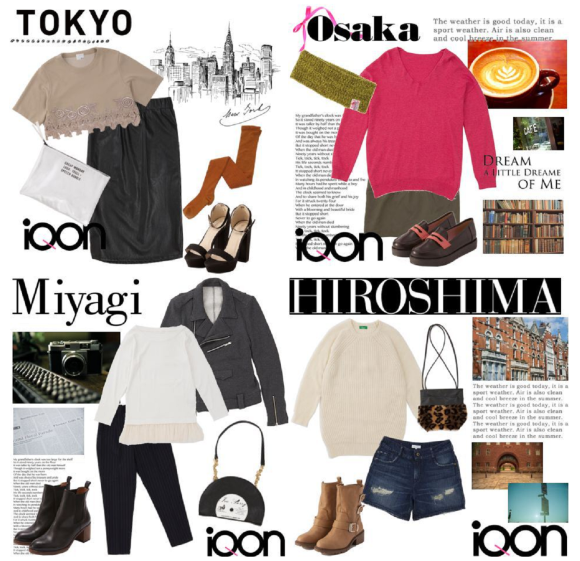
Japan isn’t that big geographically, but it’s still divided up into 47 different prefectures. Even though it’ll usually only take you a couple of hours to pass from one into the other (and even less if you’re on the Shinkansen), each has its own unique feel to it. Depending on where you are, people eat different foods, celebrate holidays in different ways, and even like different clothes, as shown by a study that reveals how Japanese women like to dress by prefecture.
The staff of popular fashion website and smartphone app iQON compiled their lists by examining which fashion items users from each prefecture had clicked to like. After sifting through roughly 20 million likes, iQON had enough data to put together an ensemble for each prefecture for its Japanese Fashion Baseline Outfits 2014 list.
Starting with Tokyo, locals reach for skirts and other feminine yet sophisticated articles of clothing before heading out into Japan’s political and fashion capital.
Osaka, Tokyo’s outspoken rival in the west, displayed a strong preference for minidresses and head wraps, plus the color pink.
Meanwhile, Aichi, which includes the city of Nagoya, says those Tokyo and Osaka girls can keep their bare legs to themselves, and showed its love for pants and sunglasses.
Saitama and Chiba, which border Tokyo on the north and east, respectively, occasionally bicker over which is the cooler prefecture. If you accept Tokyo as the pinnacle of the Japanese fashion scene, it looks like Saitama comes out the winner, as its skirt and snappy coat are closer to Tokyo’s above style than Chiba’s dressed-down look.
Meanwhile, Kanagawa, Tokyo’s southern neighbor, doesn’t stoop to such petty debates, and is content to rock its denim shorts and sporty backpacks at the prefecture’s numerous beaches.
As you might expect, tropical Okinawa also picks fashions appropriate for a day on the sand.
Users from Fukushima gave plenty of likes to sky blue and pink items, plus tulle skirts. The prefecture is just enough north that residents will probably get a lot of use out of that parka’s hood, too.
The climate probably also had a hand in making this warm-looking cap a top pick in mountainous Gunma, where the choice of pants over skirts will come in handy if anyone decides to go for a ride on prefectural mascot/yuru-kyara grand champion/adorable horse Gunma-chan.
It’s not just weather that can affect fashion, though, but sometimes even local produce. Mention Aomori Prefecture to just about anyone in Japan, and one of the first things they’ll think of are its delicious apples, which might explain why the prefecture showed a fondness for red-tinged items.
This might be stretching things a little, but could it be there’s also a connection between Miyagi’s leather jacket and the fact that Sendai, its biggest city, is famous for beef tongue?
The relationship between food and clothing isn’t absolute, though. Despite having access to some fantastic cream-based treats, the ladies of Hiroshima still feel confident enough in their legs to regularly like outfits that show off their thighs.
Yamanashi, also, is comfortable with having its knees seen, albeit in a daintier way than Hiroshima.
Kobe, in Hyogo Prefecture, has long had a reputation as one of the more elegant cities in Japan, an image that’s only reinforced by Hyogo’s tight-fitting skirt and jaunty cap.
Tokushima, on the island of Shikoku, may not get much national media attention, but its eye-catching ensemble is one of the most feminine on iQON’s list.
Between Japan’s lingering economic troubles and cultural preference for not standing out too much, nationwide, iQON users’ tastes skewed toward understated colors such as white, black, and gray. That wasn’t the case in Shiga, though, which went with oranges, greens, and yellows, or what Japan calls “vitamin colors” due to the way they evoke thoughts of vitamin C-packed citrus fruits.
But no one bucked the monochrome trend as hard as Kagoshima. Located at the very southern tip of the island of Kyushu, the prefecture can’t get enough of yellow, pink, and orange.
iQON’s theory for this is because Kagoshima City, the prefecture’s largest town, sits across a bay from active volcano Sakurajima. Sakurajima regularly covers Kagoshima in a thin layer of ash, causing fashionable women to avoid white and black clothing, iQON says, on which flecks of ash would be easily visible.
We’re not sure how solid that logic is, but in a city where the skies so often turn gray, we’re sure everyone appreciates the splashes of color.
Source, images: iQON
[ Read in Japanese ]